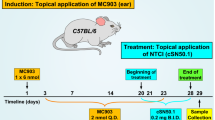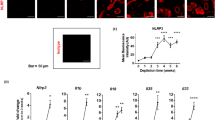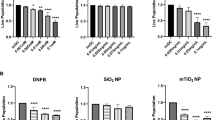Abstract
We herein demonstrate that STAT6 plays an important role in the induction of not only acute contact hypersensitivity (CHS), but also chronic CHS in a mouse model using STAT6-deficient (STAT6−/−) mice. We, therefore, determine whether synthetic double-stranded DNA with a high affinity for STAT6 can be introduced in vivo as a decoy cis element to bind the transcriptional factor and block the induction of not only acute CHS but also chronic CHS. Treatment by the transfection of STAT6 decoy oligodeoxynucleotides (ODN), after the induction of 2,4,6-trinitrochlorobenzene or other haptens had a significant inhibitory effect on the induction of both acute CHS and chronic CHS. We thus examined the mechanism of the in vivo effect of the transfection of STAT6 decoy ODN in both acute and chronic CHS. In the histological analysis, the infiltration of eosinophils and degranulated mast cells, and the production of IL-4, IL-6 and eotaxin, but not IFN-γ in the extracts from challenged skin significantly decreased by the transfection of STAT6 decoy ODN. We herein report the first successful in vivo transfer of STAT6 decoy ODN to inhibit acute and chronic CHS, thus providing a new therapeutic strategy not only for the treatment of CHS but also for atopic dermatitis.
This is a preview of subscription content, access via your institution
Access options
Subscribe to this journal
Receive 12 print issues and online access
$259.00 per year
only $21.58 per issue
Buy this article
- Purchase on Springer Link
- Instant access to full article PDF
Prices may be subject to local taxes which are calculated during checkout





Similar content being viewed by others
References
Xu H, DiIulio NA, Fairchild RL . T cell populations primed by hapten sensitization in contact sensitivity are distinguished by polarized patterns of cytokine production: interferon gamma-producing (Tc1) effector CD8+ T cells and interleukin (IL)-4/IL-10-producing (Th2) negative regulatory CD4+ T cells. J Exp Med 1996; 183: 1001–1012.
Steinbrink K, Sorg C, Macher E . Low zone tolerance to contact allergens in mice: a functional role for CD8+ T helper type 2 cells. J Exp Med 1996; 183: 759–768.
Gautam SC, Chikkala NF, Hamilton TA . Anti-inflammatory action of IL-4. Negative regulation of contact sensitivity to trinitrochlorobenzene. J Immunol 1992; 148: 1411–1415.
Asada H, Linton J, Katz SI . Cytokine gene expression during the elicitation phase of contact sensitivity: regulation by endogeneous IL-4. J Invest Dermatol 1997; 108: 406–411.
Dieli F et al. IL-4 is essential for the systemic transfer of delayed hypersensitivity by T cell lines. Role of gamma/delta cells. J Immunol 1994; 152: 2698–2704.
Salerno A et al. IL-4 is a critical cytokine in contact sensitivity. Immunology 1995; 84: 404–409.
Asherson GL et al. Role of IL-4 in delayed type hypersensitivity. Clin Exp Immunol 1996; 103: 1–4.
Weigmann B et al. Diminished contact hypersensitivity response in IL-4 deficient mice at a late phase of the elicitation reaction. Scand J Immunol 1997; 45: 308–314.
Takeda K et al. Essential role of Stat6 in IL-4 signaling. Nature 1996; 380: 627–630.
Yokozeki H et al. Signal transducer and activator of transcription 6 is essential in the induction of contact hypersensitivity. J Exp Med 2000; 191: 995–1004.
Yokozeki H et al. Gammadelta T cells assist alphabeta T cells in the adoptive transfer of contact hypersensitivity to para-phenylenediamine. Clin Exp Immunol 2001; 125: 351–359.
Yokozeki H et al. Th2 cytokines, IgE and mast cells play a crucial role in the induction of para-phenylenediamine-induced contact hypersensitivity in mice. Clin Exp Immunol 2003; 132: 385–392.
Kitagaki H et al. Immediate-type hypersensitivity response followed by a late reaction is induced by repeated epicutaneous application of contact sensitizing agents in mice. J Invest Dermatol 1995; 105: 749–755.
Kitagaki H et al. Repeated elicitation of contact hypersensitivity induces a shift in cutaneous cytokine milieu from a T helper cell type 1 to a T helper cell type 2 profile. J Immunol 1997; 159: 2484–2491.
Morishita R et al. Application of transcription factor ‘decoy’ strategy as means of gene therapy and study of gene expression in cardiovascular disease. Circ Res 1998; 82: 1023–1028.
Morishita R, Aoki M, Kaneda Y . Oligonucleotides-based gene therapy for cardiovascular disease: are oligonucleotide therapeutics novel cardiovascular drugs? Curr Drug Targets 2000; 1: 15–23.
Morishita R et al. In vivo transfection of cis-element ‘decoy’ against nuclear factor-kappaB binding site prevents myocardial infarction. Nat Med 1997; 3: 894–899.
Tomita T et al. Suppressed severity of collagen-induced arthritis by in vivo transfection of nuclear factor kappaB decoy oligodeoxynucleotides as a gene therapy. Arthritis Rheum 1999; 42: 2532–2542.
Kawamura I et al. Intratumoral injection of oligonucleotides to the NF kappaB binding site inhibits cachexia in a mouse tumor model. Gene Therapy 1999; 6: 91–97.
Tomita N et al. In vivo administration of a nuclear transcription factor-kappaB decoy suppresses experimental crescentic glomerulonephritis. J Am Soc Nephrol 2000; 11: 1244–1252.
Kawamura I et al. Intravenous injection of oligodeoxynucleotides to the NF-kappaB binding site inhibits hepatic metastasis of M5076 reticulosarcoma in mice. Gene Therapy 2001; 8: 905–912.
Abeyama K et al. A role of NF-kappaB-dependent gene transactivation in sunburn. J Clin Invest 2000; 105: 1751–1759.
Nakamura H et al. Prevention and regression of atopic dermatitis by ointment containing NF-kB decoy oligodeoxynucleotides in NC/Nga atopic mouse model. Gene Therapy 2002; 9: 1221–1229.
Muller KM et al. Th2 cells mediate IL-4-dependent local tissue inflammation. J Immunol 1993; 150: 5576–5584.
Garside P, Mowat AM . Polarization of Th-cell responses: a phylogenetic consequence of nonspecific immune defence? Immunol Today 1995; 16: 220–223.
Swain SL . Generation and in vivo persistence of polarized Th 1 and Th 2 memory cells. Immunity 1994; 1: 543–552.
Kaneda Y et al. Hemagglutinating virus of Japan (HVJ) envelope vector as a versatile gene delivery system. Mol Ther 2002; 6: 219–226.
Malaviya R, Uckun FM . Role of STAT6 in IgE receptor/FcepsilonRI-mediated late phase allegic responses of mast cells. J Immunol 2002; 168: 421–426.
Hoeck J, Woisetschlager M . Activation of eotaxin-3/CCLI26 gene expression in human dermal fibroblasts is mediated by STAT6. J Immunol 2001; 167: 3216–3222.
Hoeck J, Woisetschlager M . STAT6 mediates eotaxin-1 expression in IL-4 or TNF-alpha-induced fibroblasts. J Immunol 2001; 166: 4507–4515.
Wang LH et al. Targeted disruption of stat6 DNA binding activity by an oligonucleotide decoy blocks IL-4-deriven T(H)2 cell response. Blood 2000; 95: 1249–1257.
Molitor JA et al. NF-kappaB. A family of inducible and differentially expressed enhancer-binding proteins in human T cells. Proc Natl Acad Sci USA 1990; 87: 10028–10032.
Schreiber E et al. Rapid detection of octamer binding proteins with ‘mini-extracts’, prepared from a small number of cells. Nucleic Acids Res 1989; 17: 6419.
Ferguson TA, Dube P, Griffith TS . Regulation of contact hypersensitivity by interleukin 10. J Exp Med 1994; 179: 1597–1604.
Acknowledgements
We thank Ms Motoko Sekiya for her excellent technical assistance.
Author information
Authors and Affiliations
Rights and permissions
About this article
Cite this article
Sumi, K., Yokozeki, H., Wu, MH. et al. In vivo transfection of a cis element ‘decoy’ against signal transducers and activators of the transcription 6 (STAT6) binding site ameliorates the response of contact hypersensitivity. Gene Ther 11, 1763–1771 (2004). https://doi.org/10.1038/sj.gt.3302345
Received:
Accepted:
Published:
Issue Date:
DOI: https://doi.org/10.1038/sj.gt.3302345



